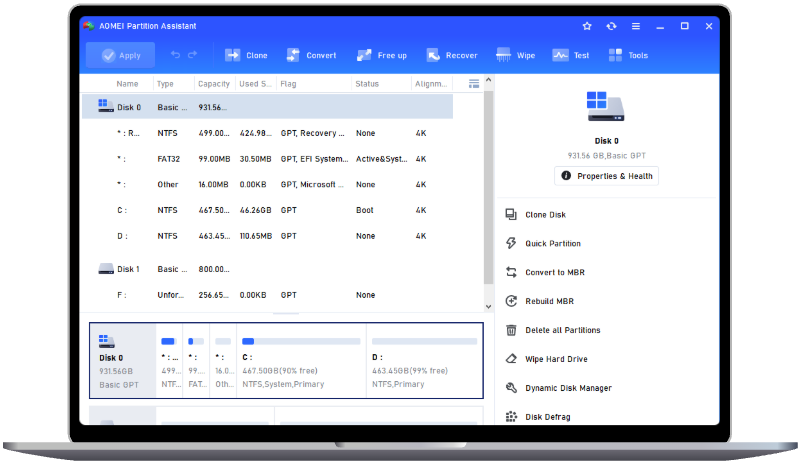Does Low Storage Make Your PC Laggy? How to Speed Up the Computer?
Does low storage make your PC laggy? You can read to know the answer and get the solutions to free up space on PC and speed up computer effectively.
Does low storage make your PC laggy?
Many Windows users might see a "Low disk space" warning, which indicates that there isn’t enough space on the C drive. After seeing it, you may feel that your PC is slowing down or even slow boot. Is this just an illusion? Does low storage make your PC laggy? Yes, it does.
When your computer’s storage (like a hard drive or SSD) is nearly full, it struggles to perform basic tasks. Every time you open a program, save a file, or even update your system, the PC needs space to create temporary files. If there’s not enough room, these processes take longer, causing delays.
Another reason is virtual memory. Your PC uses part of the storage as "extra RAM" to handle multiple tasks. When storage is low, the system can’t manage this efficiently, leading to slower performance, especially when running many apps at once.
Fragmentation is also a problem for traditional hard drives (HDDs). When storage is full, files get split into smaller pieces scattered across the drive. This forces the PC to work harder to find and assemble them, slowing things down. Does SSD need defrag? No, it doesn't. While SSDs don’t face fragmentation, they still need free space to function smoothly.
Low storage can prevent software updates or new installations. Your PC might freeze or crash if it can’t download necessary updates due to lack of space. Even background tasks, like system scans, may lag because the drive is too crowded to operate efficiently. What can you do? Here are some measures you can take. Keeping at least 10-20% of your drive free helps maintain speed and stability. A little free space goes a long way in keeping your PC running smoothly!
How to free up space to speed up computer?
This section introduces 7 fixes. These will help you effectively free up space on PC and speed up computer.
Fix 1. Allocate free space
When your computer’s C drive is running low on space, using partition management software to extend it can be a quick and effective solution. AOMEI Partition Assistant offers a useful "Allocate Free Space" feature that allows you to add space from other partitions to the C drive without any data loss. To extend the C drive and free up disk space on Windows 11/10, follow these simple steps:
The Best Windows Disk Partition Manager and PC Optimizer
Tip: If there is unallocated space on your system disk, merging it with the C drive is another good option to extend its size.
Step 1. Right-click the D drive and select “Allocated Free Space”.
Step 2. In the pop-up window, you can allocate free space from D drive to C drive. And click “OK”.
Step 3. Finally, click “Apply” to execute the progress.
Fix 2. Disable unnecessary startup applications
Some programs are designed to start automatically every time when your computer boots up. These running processes in the background will waste memory and slow down your computer. Thus, disabling them can help boost Windows 10 computer performance.
Step 1. Press "Ctrl+Alt+Del" to open "Task Manager", and click the "Startup" tab to check the startup programs. You can also check the "Startup Impact" value for each startup program; the "High" means the programs will slow down your system significantly.
Step 2. Then you can just right-click on it and choose "Disable" to prevent it from launching on Windows startup.
Fix 3. Enable Storage Sense
You may get a low disk space warning when more and more data is stored on the hard drive, the computer will also become very slow. Luckily, the Windows built-in tool Storage Sense can make sure of cleaning your PC to make it faster automatically by deleting the files left after updating or installing system, files in the recycle bin, etc.
Step 1. Click "Start" and "Settings" to open "Windows Settings", then click "System".
Step 2. Select "Storage" and turn on "Storage Sense", then click "Configure Storage Sense or run it now".
Step 3. In the pop up window, you can set the proper time to run Storage Sense.
Fix 4. Run an HDD disk defragment
Fragmentation is an issue for traditional hard drives (HDDs). When the storage is nearly full, files are broken into smaller parts and spread across different areas of the drive. As a result, the computer has to work harder to find these scattered pieces and put them together, which slows down performance.
AOMEI Partition Assistant (compatible with Windows 11/10/8/7) is a powerful and user-friendly tool for HDD disk defragment. Its intuitive GUI makes it easy to manage disks and partitions with just a few clicks, without the need for complex commands.
The Best Windows Disk Partition Manager and PC Optimizer
Step 1. On the main interface of AOMEI Partition Assistant, all your disks are listed. Find the disk you want to defragment (take Disk 0 as an example), right-click and select Disk Defrag.
Step 2. After that, all NTFS partitions on the disk will be listed. Because this function can only run on NTFS partitions currently. You can click Analyze to check partition.
Step 3. Wait a moment, Your partition status will be expressed in the form of scores. There are three results:
Normal: Score≥90. The current partition is in good condition, no need for defragmentation.
Suggest to organize: 60≤Score<90. The current partition has some fragments, suggest to run the defragmentation.
Organize now: Score<60. There are many fragments in the current partition, suggest to run the defragmentation immediately.
Step 4. You can click “Details” to view more information about the analysis results, or you can directly click “Defrag” to perform defragment.
Fix 5. Delete system restore point
Windows can help you back up the system regularly, so these backup files will take up a certain amount of disk space. You can delete all backup files but the most recent restore point. In this way, when the system fails, you can still restore the computer to the latest version.
Step 1. In “This PC”, right-click C drive and select “Properties”.
Step 2. In the new window, click “Clean up system files”.
Step 3. In the new window, select “More Options”, then click “Clean up” under “System Restore and Shadow Copies”.
Fix 6. Uninstall some programs
Windows has many built-in programs (especially in Windows 10 and 11), and you may never use some of them. So, you can uninstall the programs that you do not actually need, and you can uninstall less frequently used applications to free up space.
Step 1. Click the "Start" button.
Step 2. Then, click “Control Panel” > “Programs” > “Uninstall a program”.
Fix 7. Move installed apps to another drive
If you don't want to uninstall any program, or even there is nothing to delete, you can also try to move installed apps to another drive. The App Mover feature of AOMEI Partition Assistant lets you transfer programs from the C drive to another drive to free up space. The benefit is that it not only clears space but also preserves the programs, allowing them to run directly from the new location without any issues.
The Best Windows Disk Partition Manager and PC Optimizer
Step 1. Install and launch the multifunctional software, click “Tools” on the right, then select the “App Mover” under "Free up".
Step 2. Choose C drive and click "Next".
Step 3. Select apps you want to move, choose the destination path and click on "Move".
Step 4. Click "OK" on the pop-up window.
Conclusion
Does low storage make your PC laggy? Yes, low storage can indeed slow down your PC, causing issues like delayed boot times, lagging applications, and difficulty running multiple tasks. By keeping your storage free and managing space efficiently, you can maintain your system’s speed and stability. Tools like AOMEI Partition Assistant, which help allocate free space, defragment disks, and move installed apps, are great solutions to optimize your PC. Regular maintenance and freeing up disk space can ensure your computer runs smoothly and efficiently.


